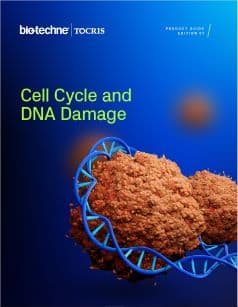IRE1
Inositol-requiring enzyme 1 (IRE1) is a resident transmembrane ER protein with both kinase and endonuclease domains. Both yeast (IRE) and mammalian (IRE1α) homologs are involved in the degradation of misfolded proteins, as part of the unfolded protein response (UPR).
IRE1 Inhibitors |
|
|---|---|
| Cat. No. | Product Name / Activity |
| 4479 | 4μ8C |
| Inhibits IRE1α endoribonuclease activity | |
| 6166 | AMG 18 hydrochloride |
| Potent and selective IRE1α inhibitor | |
| 6009 | B I09 |
| IRE1 endonuclease inhibitor; cell permeable | |
| 4509 | STF 083010 |
| Inhibits IRE1α endonuclease activity | |
Other |
|
| Cat. No. | Product Name / Activity |
| 4865 | APY 29 |
| Inhibits IRE1α autophosphorylation; activates IRE1α endoribonuclease activity | |
| 3603 | Kaempferol |
| MCU activator; also promotes IRE1 activity | |
| 1125 | Quercetin |
| Non-selective PI 3-kinase inhibitor; promotes IRE1 endonuclease activity | |
Inositol-requiring enzyme 1 (IRE1), also known as endoplasmic reticulum to nucleus signaling 1 (ERN1), is a resident transmembrane ER protein with both kinase and endonuclease domains. Both yeast (IRE1) and mammalian (IRE1α) homologs are involved in the degradation of misfolded proteins, as part of the unfolded protein response (UPR). IRE1 (yeast) is involved in the endonucleolytic cleavage of HAC1 mRNA, whereas IRE1α (human) catalyzes the splicing of X-box binding protein (XBP) 1 mRNA. XBP1 mRNA splicing triggers upregulation of genes involved in the ERAD pathway, induction of XBP1 expression and the synthesis of ER chaperones.
Under normal conditions, IRE1 is maintained in an inactive state due to the binding of B-cell immunoglobulin binding protein (BiP) to its luminal domain. However, the accumulation of unfolded proteins within the ER induces ER stress, causing BiP to detach from IRE1. Following BiP detachment, IRE1 undergoes dimerization and autophosphorylation through the actions of IRE1 kinase domains. Activation of IRE1 endonuclease and kinase domains may also occur by direct binding of unfolded proteins to IRE1.
External sources of pharmacological information for IRE1 :
Literature for IRE1
Tocris offers the following scientific literature for IRE1 to showcase our products. We invite you to request* your copy today!
*Please note that Tocris will only send literature to established scientific business / institute addresses.
Cell Cycle and DNA Damage Research Product Guide
This product guide provides a review of the cell cycle and DNA damage research area and lists over 150 products, including research tools for:
- Cell Cycle and Mitosis
- DNA Damage Repair
- Targeted Protein Degradation
- Ubiquitin Proteasome Pathway
- Chemotherapy Targets
